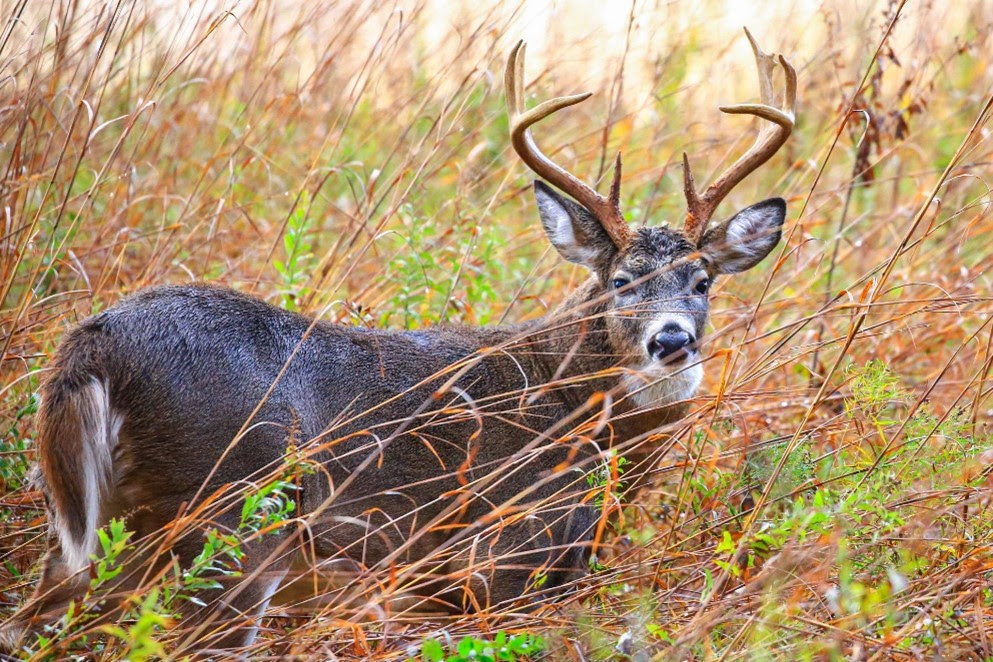
A white-tailed buck in a field. The Rhode Island Department of Environmental Management plans to conduct an aerial survey this winter to calculate a new estimate for the state’s deer population.
(Photo by Dean Birch)
If the number of deer brought by hunters to Rhode Island Department of Environmental Management (DEM)-operated biological check stations during the first weekend in November is any indication, it’s going to be a good hunting season.
The DEM Division of Fish and Wildlife recorded a total of 236 harvested deer checked in at the state’s six stations on Saturday, Nov. 2, and Sunday, Nov. 3, the first weekend of muzzleloader season.
That’s almost as many as the 245 brought to check-in stations over the first weekend of muzzleloader season and the first weekend of shotgun season combined last year.
Hunters must check in the deer they kill during the first two days of each firearm season so that state biologists can collect tissue samples and data to learn more about the overall health of Rhode Island’s deer herd. The first weekend of shotgun season is Dec. 7 and 8. Deer taken with archery equipment must also be brought to check-in stations.
“I think we could potentially break our record harvest this year,” said DEM Principal Wildlife Biologist Dylan Ferreira.
The state’s record deer harvest of 2,937 was in the 2008-2009 winter season, Ferreira said. Last year, the deer harvest was 2,794.

Ferreira said 215 deer taken by hunters on opening weekend were shot with a muzzleloader while 21 were archery kills — 12 by hunters using a vertical bow and nine by crossbow. In all, 173 males and 63 females were checked.
The biggest deer was an eight-point buck weighing about 200 pounds killed on Nov. 2 in Scituate by a hunter using a vertical bow, Ferreira said.
Seventeen DEM staff members assisted by 12 volunteers worked over the weekend at the six check-in stations. Here’s the breakdown of deer checked in at each one:
- 68 at George Washington Management Area in Chepachet
- 68 at Arcadia Management Area at Wood River in Exeter
- 29 at Carolina Management Area: Pine Hill Road, Richmond, (41.46618,
- 27 at Smithfield Sportsman Club in Smithfield
- 24 at Great Swamp Management Area in West Kingston
- 19 at Tiverton Rod and Gun Club in Tiverton
State biologists take samples of teeth and lymph nodes from each deer. The lymph nodes will be sent to a laboratory at the New Bolton Center Diagnostic Laboratories at the University of Pennsylvania School of Veterinary Medicine to test for the presence of chronic wasting disease (CWD), a fatal neurological disease that affects deer, elk, moose, reindeer that has spread to more than half of the states in the continental United States. Infected deer become unable to eat and show a lack of fear of humans.
So far, CWD has not been detected in Rhode Island. This year is the 23rd year of testing for the disease.
Good weather helped usher in muzzleloader season, which runs each year from the first Saturday in November through the Sunday after Thanksgiving. With Thanksgiving falling later in the month this year, muzzleloader season is an extra weekend longer this year.
Early November finds deer are in the middle of their breeding season, or rut. Bucks are generally more active and easier to hunt. But an abundance of acorns this year has meant deer don’t have to roam as much for food, Ferreira said.
“Lot of acorns, more than I can ever remember,” he added.
DEM officials are planning to conduct an aerial monitoring survey this winter to calculate the size of the state’s deer population, which some estimates put over 20,000. In 2004, the deer herd across Rhode Island was estimated at nearly 16,000.
There were 1,347 deer vehicle collisions reported to DEM’s Division of Law Enforcement in 2023, an 11% decrease compared to 2022 when 1,544 deer auto strikes were reported. In 2023, the number of reported deer auto strikes was equivalent to 49% of the total reported hunter harvest.
GET THE MORNING HEADLINES.

